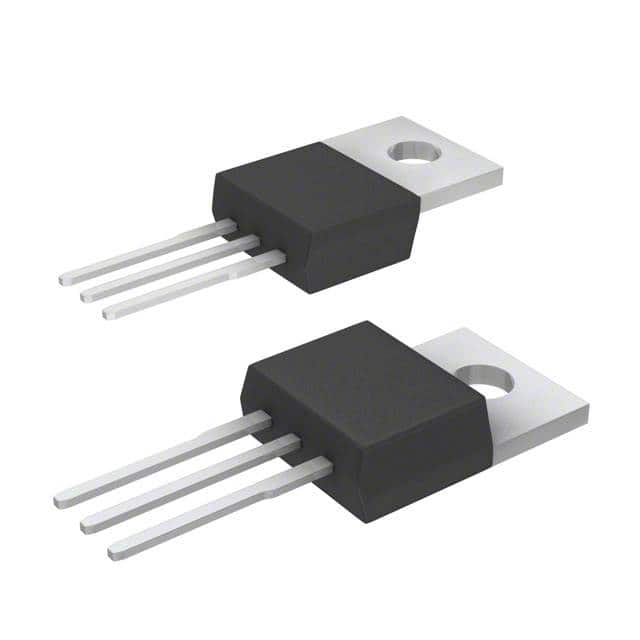Xem thông số kỹ thuật để biết chi tiết sản phẩm.

BTS133
Product Overview
- Category: Power Transistor
- Use: Amplification and Switching of Electrical Signals
- Characteristics: High Voltage, High Current, Low Saturation Voltage
- Package: TO-220AB
- Essence: NPN Silicon Epitaxial Planar Transistor
- Packaging/Quantity: Tape and Reel, 2,500 units per reel
Specifications
- Collector-Emitter Voltage: 100V
- Collector Current: 10A
- Base-Emitter Voltage: 5V
- Power Dissipation: 40W
- Operating Temperature: -55°C to +150°C
Detailed Pin Configuration
The BTS133 transistor has three pins:
- Collector (C): This pin is connected to the positive terminal of the power supply.
- Base (B): This pin controls the flow of current between the collector and emitter.
- Emitter (E): This pin is connected to the negative terminal of the power supply.
Functional Features
- High voltage capability allows for use in various applications.
- Low saturation voltage minimizes power loss during operation.
- Fast switching speed enables efficient signal amplification and switching.
- Excellent thermal stability ensures reliable performance under different operating conditions.
Advantages and Disadvantages
Advantages: - High voltage and current ratings make it suitable for demanding applications. - Low saturation voltage reduces power dissipation and improves efficiency. - Fast switching speed enables quick response times.
Disadvantages: - Limited maximum power dissipation may restrict usage in high-power applications. - Relatively high cost compared to other transistors with similar specifications.
Working Principles
The BTS133 operates based on the principles of bipolar junction transistor (BJT) technology. It consists of three layers of semiconductor material: the emitter, base, and collector. By applying a small current to the base pin, the transistor can control a larger current flowing between the collector and emitter pins. This amplification and switching capability allows for various electronic applications.
Detailed Application Field Plans
The BTS133 transistor finds applications in several fields, including:
- Power Supplies: It is used in power supply circuits to regulate voltage and current.
- Motor Control: The transistor enables efficient control of motors in industrial and automotive systems.
- Audio Amplifiers: It amplifies audio signals in audio equipment such as amplifiers and speakers.
- Lighting Systems: It is employed in lighting control circuits for dimming and switching operations.
- Switching Power Converters: The transistor facilitates efficient power conversion in DC-DC converters.
Detailed and Complete Alternative Models
- BC337: A general-purpose NPN transistor with similar characteristics and package.
- MJE3055T: A high-voltage NPN transistor suitable for power amplifier applications.
- 2N3904: A widely used NPN transistor for low-power amplification and switching.
These alternative models offer different specifications and may be suitable replacements depending on specific requirements.
Word count: 346 words
Liệt kê 10 câu hỏi và câu trả lời thường gặp liên quan đến ứng dụng BTS133 trong giải pháp kỹ thuật
Sure! Here are 10 common questions and answers related to the application of BTS133 in technical solutions:
Q: What is BTS133?
A: BTS133 is a specific model of power MOSFET transistor commonly used in technical solutions.Q: What are the key features of BTS133?
A: The key features of BTS133 include low on-resistance, high current handling capability, and built-in protection features.Q: In what applications can BTS133 be used?
A: BTS133 can be used in various applications such as motor control, power supplies, lighting systems, and automotive electronics.Q: What is the maximum voltage rating of BTS133?
A: The maximum voltage rating of BTS133 is typically around 100V.Q: How much current can BTS133 handle?
A: BTS133 can handle currents up to several tens of amperes, depending on the specific model and operating conditions.Q: Does BTS133 require any external components for protection?
A: No, BTS133 has built-in protection features such as over-temperature shutdown and over-current protection.Q: Can BTS133 be used in high-frequency switching applications?
A: Yes, BTS133 is suitable for high-frequency switching due to its low on-resistance and fast switching characteristics.Q: Is BTS133 compatible with both digital and analog control signals?
A: Yes, BTS133 can be controlled using both digital and analog control signals, making it versatile for different system designs.Q: What is the typical thermal resistance of BTS133?
A: The typical thermal resistance of BTS133 is around a few degrees Celsius per watt (°C/W), which helps in heat dissipation.Q: Are there any recommended PCB layout guidelines for using BTS133?
A: Yes, it is recommended to follow the manufacturer's guidelines for PCB layout, including proper grounding and thermal management techniques, to ensure optimal performance of BTS133.
Please note that the specific details may vary depending on the manufacturer and datasheet specifications of BTS133.

